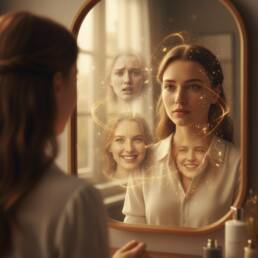People don’t buy products. They buy meaning.
They don’t buy detergent; they buy the promise of a clean home.
They don’t buy a coffee; they buy the moment of quiet before a hard day.
They don’t buy a brand; they buy a story they can see themselves in.
In a world where the audience is exposed to thousands of advertisements daily, storytelling is no longer just a communication technique, it is a real sales strategy.
It transforms reason into experience and the product into an emotional journey.
A successful video doesn’t just sell a product; it sells the emotion that product ignites. And behind that emotion lies a clear, calculated architecture, built on psychological and narrative principles.

From product to story
Most video campaigns fail, not because the product is weak, but because the story is missing. Brands talk about features, prices, and offers, but forget to create the emotional context. And without context, there is no relevance.
A simple example: a shampoo that promises “intense hydration” is forgotten in seconds. But if you show a woman preparing for her first job interview, and the moment she styles her hair becomes the symbol of regaining her confidence, the emotion remains. The story gives the product meaning. People don’t connect with what the brand does, but with how they feel in relation to it. When the emotion is authentic, the sale no longer feels like a transaction, but a natural consequence.

Storytelling as conversion architecture
Effective storytelling is not just about emotion. It is a structured strategy. A story that sells must guide the audience from identification to desire, and then to action. Essentially, the universal structure remains the same: the conflict, the solution, and the emotional resolution.
The conflict is the moment you reveal a need, a problem the audience can identify with.
The solution is the product’s promise, subtly introduced, not imposed.
The resolution is the emotional reward, the moment of fulfillment or transformation.
The difference between a classic advertisement and a good story is the order in which they are presented. The ad starts with the product, while the story starts with the person. Advertising says, “We have the perfect solution for you.” Storytelling says, “We know exactly how you feel.” At that moment, the barrier disappears, and the sale becomes a natural extension of empathy.

From rational to visual: How to translate benefits into emotions
Rational marketing talks about what the product does. Visual storytelling shows what the product changes in a person’s life. For example, a laptop that “has a 10-hour battery life” is a logical, but not emotional, statement. If you transform the same message into a story, a young person working in a café until sunset, unafraid that inspiration will die with the battery, you transmit freedom, not autonomy.
Behind every rational advantage lies an emotion:
- Power means confidence.
- Speed means freedom.
- Durability means safety.
- Aesthetics means status.
The marketer’s role is not to describe the product, but to translate it into the language of human experience. The audience does not buy specifications. They buy the way they will feel afterwards.

Why It works: The psychology of emotional decisions
The human brain does not decide logically. The emotional response comes first, and the rational justification follows only after. Neuromarketing studies show that when we watch a story, the brain activates regions associated with empathy, memory, and anticipatory pleasure. In short, emotion triggers the decision, not the argument.
A well-constructed visual storytelling campaign stimulates the secretion of oxytocin, the hormone of connection. When the audience recognizes themselves in a story, the brain interprets it as a personal experience. At that moment, the product becomes part of their identity. This is the difference between a video that informs and one that transforms: the first tells you what it is, the second shows you how you feel. And people remember emotions, not details.

How to apply storytelling in video campaigns
The story sells because it organizes the viewer’s emotional chaos. It makes them recognize themselves, feel, and anticipate. To apply storytelling effectively in video campaigns, marketers must shift their perspective: from product to emotion, from argument to experience.
A few simple principles can completely change a campaign’s results:
- Start with a clear emotion, not the product. Choose a recognizable state: frustration, courage, hope, desire.
- Show the transformation, not the product. Let the character move from one state to another.
- Use rhythm, music, and color as part of the story. Cool lights convey tension; warm lights offer comfort.
- End with recognition, that moment when the viewer says, “This is my story, too.”
An effective video campaign does not end with a logo, but with an emotion that lingers. If, after the clip has finished, the audience feels something, the story has worked.

Conclusion
Storytelling is not a fad; it is the language through which people understand the world. In a market saturated with messages, the brands that know how to turn a simple advertisement into an experience win. A good story doesn’t sell directly. But it makes the audience want to buy.
This is, in fact, the elegance of marketing: to convince without pushing.
At Cabo Studio, we believe every brand has a story worth telling visually.
Not one written in PowerPoint, but one felt in the heart.
Because, in the end, it’s not the product that sells, but the story people choose to believe about it.
